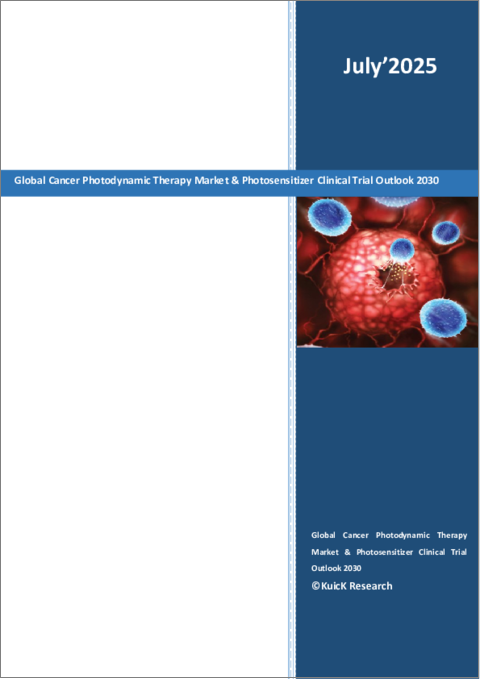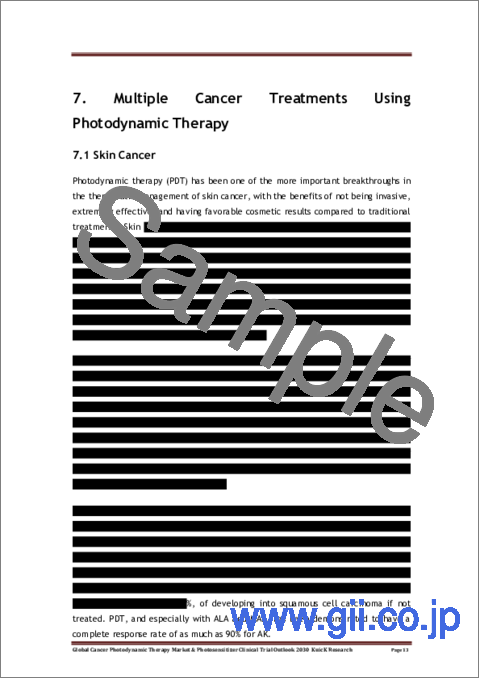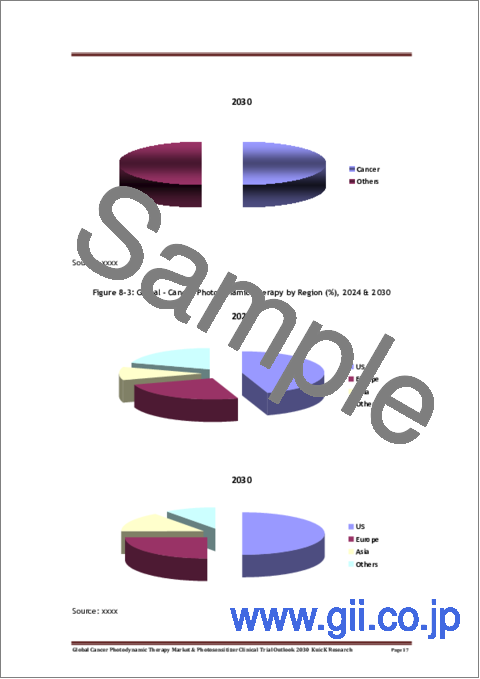|
|
市場調査レポート
商品コード
1769431
がん光線力学的療法の世界市場:光増感剤の臨床試験見通し(2030年)Global Cancer Photodynamic Therapy Market & Photosensitizer Clinical Trial Outlook 2030 |
||||||
|
|||||||
| がん光線力学的療法の世界市場:光増感剤の臨床試験見通し(2030年) |
|
出版日: 2025年07月01日
発行: KuicK Research
ページ情報: 英文 220 Pages
納期: 即日から翌営業日
|
全表示
- 概要
- 図表
- 目次
がん光線力学的療法の世界市場:光増感剤の臨床試験見通し(2030年)レポートハイライト:
- 調査手法
- がん光線力学的療法の手技の枠組み概要
- 世界のがん光線力学的療法市場の機会:60億米ドル以上
- 世界の市場動向と地域別市場動向の洞察
- 光線力学的療法の統合:適応症別
- 臨床試験中のがん光増感剤に関する洞察:10件以上
- 世界の光増感剤の臨床パイプライン:企業別、適応症別、相別
- 相乗的光線力学的療法別腫瘍根絶のための主要アプローチに関する洞察
- 競合情勢
光線力学的療法の必要性と当レポートの意義
光線力学的療法(PDT)は、その新規作用機序と強力な局所効果により、従来のがん治療の貴重な代替療法および補助療法となりつつあります。光線力学的療法は、光増感剤、特定波長の光、組織結合酸素という3つの薬剤を使用して、がん細胞を選択的に破壊する細胞毒性活性酸素種を生成します。このようなメカニズムにより、隣接する健康な組織へのダメージを最小限に抑えながら、部位特異的に腫瘍を死滅させることができます。これは、全身毒性や付随的な組織破壊を引き起こしがちな化学療法や放射線療法に比べ、大きな利点です。
光線力学的療法の必要性は、皮膚、食道、肺、子宮頸部など、美容的にも機能的にも重要な部位のがんの治療において特に明らかになっています。累積毒性を伴わずに光線力学的療法を数回再施行できる可能性が、再発腫瘍や切除不能腫瘍の管理におけるその重要性をさらに高めています。さらに、局所的な免疫反応を誘導し、臓器機能を維持する光線力学的療法の能力は、専門医の間で人気が高まっています。
当レポートは、ダイナミックな治療戦略としての光線力学的療法の広範な概要を提供するために作成されました。当レポートでは、光線力学的療法のメカニズム的な利点、規制当局が承認した適応、問題点、現在の技術革新についてまとめており、光線力学的療法は腫瘍学と非腫瘍学の両分野で高い可能性を秘めた治療法です。
報告書に含まれる臨床試験の洞察
光線力学的療法は、複数の腫瘍や病期において臨床試験が盛んに行われています。多くの光増感剤が、第III相臨床試験を成功裏に終え、個々の適応症ですでに規制当局の承認を得ています。初めて市販された光線力学的療法剤であるポルフィマーナトリウム(フォトフリン)は、食道がん、非小細胞肺がん、バレット食道などの前がん病変に有効であることが示されました。アミノレブリン酸(ALA)およびその類似体であるMALは、皮膚科学的試験の結果、光線性角化症および表在性基底細胞がんに対して承認されており、美容的ダメージはほとんどなく、優れた病変除去を達成しています。
テモポルフィンのような最新の薬剤も、頭頸部がんに対してさらに試験が行われています。光線力学的療法はまた、神経膠腫、胆管がん、眼内腫瘍を対象とした複数の第II相および第III相試験で検討されており、多くの場合、他の治療選択肢がほとんどない集団で実施されています。本報告書には、光増感剤の種類、光照射の技術、酸素化の状態、患者報告アウトカムなどの変数を含む、これらの試験のデザインと結果に関する情報が含まれています。
さらに、初期段階の臨床試験では、治療成績の向上と腫瘍抵抗性の克服を目的として、光線力学的療法と免疫療法や化学療法との併用が評価されています。このようなコンビナトリアル戦略は、光線力学的療法の局所的効果と全身的な免疫活性化または細胞毒性シナジーの統合を目指すものであり、支持を集めています。
光線力学的療法の研究開発に関与する主要企業
様々なバイオテクノロジー企業や製薬企業、学術機関が光線力学的療法プラットフォームの開発と最適化に取り組んでいます。Pinnacle Biologics、Biofrontera、Soligenix、Steba Biotechなどの業界大手は、薬物動態を改善し、感光時間を短縮し、腫瘍特異性を高めた次世代光増感剤の開発に取り組んでいます。例えば、バイオフロンテラ社は、米国とEUにおいて、ALAをベースとした光線力学的療法製品を皮膚科用途で数種類販売しています。
Roswell Park Comprehensive Cancer Center、University College London、Harvard Medical Schoolなどの学術機関は、新しい光送達システムの開発や光線力学的療法による免疫メカニズムの研究において重要な役割を果たしています。これらの研究は、光線力学的療法を新たな腫瘍学的・非腫瘍学的フロンティアに拡大しようとする現在の共同研究や臨床提携の基盤となっています。
同時に、技術ベンチャーは、人工知能に支えられたナノテクノロジーとドラッグ・デザインを用いて、光増感剤のターゲティングを強化し、オフターゲット効果を最小化するインテリジェント・デリバリー・システムを開発しています。このような開発により、光線力学的療法治療の応用範囲と安全性プロファイルが拡大しています。
光線力学的療法分野の今後の方向性を示すレポート
治療上の重要性が証明されたとはいえ、光線力学的療法は科学的・技術的な革新を通じて開発が続けられています。今後の開発段階では、現在の欠点である光の透過深度、酸素依存性、長期的な光感受性に対処する必要があります。これらを抑制するために、研究者たちは近赤外線活性化光増感剤、腫瘍を標的としたナノ粒子、酸素に依存しない反応機構を工学的に研究しています。
光線力学的療法とチェックポイント阻害剤を含む免疫療法との併用は、将来有望な開発分野の一つです。光線力学的療法は、腫瘍に関連した抗原を送達し、免疫原性の細胞死を誘導することができるため、免疫系によるがんとの闘いの可能性を高める治療法との相性は抜群です。この組み合わせは、いくつかの前臨床モデルや初期段階の臨床試験で検討されています。
さらに、ナノキャリアベースのデリバリーシステムを組み込むことで、光増感剤の薬理学的プロファイルを強化し、腫瘍特異的なターゲティングと制御された活性化を促進することができます。また、抗菌療法、加齢黄斑変性症、自己免疫性皮膚疾患など、非腫瘍領域への光線力学的療法の応用にも関心が集まっており、その幅広い治療効果が期待されています。
当レポートでは、このような将来の方向性について詳述し、新たな光増感剤の設計、新たな臨床アプローチ、光線力学的療法が確立された適応症を越えて定着する可能性のある領域についての洞察を提供します。腫瘍学、皮膚科学、バイオテクノロジー、ヘルスケア政策の利害関係者にとって、光線力学的療法分野は、精密医療や臓器温存治療の目的と交差する拡大するフロンティアです。
目次
第1章 調査手法
第2章 光線力学的がん療法とは何か
- 概要
- がん光線力学的療法の利点
- がん光線力学的療法の進化
第3章 腫瘍学における光線力学的療法の臨床的必要性
第4章 がん光線力学的療法の手技の枠組み
- 光線力学的療法の手技
- 光感受性剤を体内に投与
- 酸素:光線力学的療法における重要な基質
- 光源:安全かつ効果的な光感受性剤活性化の鍵
第5章 光線力学的療法における光感受性物質の送達の最適化
- 有機ナノ粒子:薬物の担持容量と溶解性の向上
- 光力学的療法における光増感剤の担体としての無機ナノキャリア
治療
第6章 光線力学的療法の抗腫瘍活性
- 光線力学的療法別腫瘍への直接的なダメージ
- 血管損傷
- 炎症と免疫反応
第7章 光線力学的療法を用いた複数のがん治療
- 皮膚がん
- 前立腺がん
- 口腔病変と食道がん
- 肺がん
- 乳がん
- 脳腫瘍
- 頭頸部がん
- 婦人科がん
- 大腸がん
- 胆道がんおよび膵臓がん
第8章 世界のがん光線力学的療法市場の見通し
- 現在の市場シナリオ
- 将来の市場機会
第9章 地域別光線力学的療法市場分析
- 北米
- 欧州
- アジア太平洋
- ラテンアメリカ、中東・アフリカ
第10章 世界のがん治療用光感受性剤の臨床パイプラインの概要
- 相別
- 国別
- 企業別
- 適応症別
第11章 企業別、適応症別、相別の光感受性剤の世界臨床パイプライン
- 前臨床
- 第I相
- 第I/II相
- 第II相
- 第III相
第12章 企業別・適応症別光感受性剤の販売状況
第13章 腫瘍根絶のための相乗的光線力学的療法アプローチ
第14章 光線力学的療法分野の進歩
第15章 世界のがん光線力学的療法市場力学
- 有利なパラメータと機会
- 将来の市場成長への課題
第16章 競合情勢
- Asieris Pharmaceuticals
- Aura Biosciences
- Biofrontera AG
- Biolitec
- Coherent
- Galderma
- Hemerion Therapeutics
- ImPact Biotech
- Invion
- Luzitin
- Modulight Corporation
- Molteni Farmaceutici
- PCI Biotech
- PhotoBiotics
- Photolitec
- photonamic
- Pinnacle Biologics
- Rakuten Medical
- Theralase Technologies
- SBI Pharmaceuticals
- Shanghai Fudan-Zhangjiang Bio-Pharmaceutical
- Soligenix
- Sun Pharma
List of Figures
- Figure 2-1: Cancer Photodynamic Therapy - Superior Targeted Noninvasive Alternative
- Figure 2-2: Cancer Photodynamic Therapy - Evolution
- Figure 3-1: Cancer Photodynamic Therapy - Need
- Figure 4-1: Cancer Photodynamic Therapy - Working Principle
- Figure 4-2: Desired Features of Ideal Photosensitizer
- Figure 4-3: Photodynamic Therapy - Cellular Mechanism
- Figure 4-4: Photodynamic Therapy - Common Light Sources
- Figure 5-1: Photodynamic Therapy - Drug Delivery Systems
- Figure 5-2: Photosensitizer Drugs - Liposome-Based Delivery
- Figure 5-3: Quantum Dot - Structure
- Figure 5-4: Gold Nanoparticles - Targeted Photosensitizer Delivery System
- Figure 6-1: Photodynamic Therapy - Tumor Cell Apoptosis Induction
- Figure 6-2: Photodynamic Therapy - Vascular Damage Induction
- Figure 7-1: CASE2621 Phase 1/2 (NCT05020912) Trial - Study Initiation & Completion Year
- Figure 7-2: ALA-BCC-CT013 Phase 3 (NCT03573401) Trial - Study Initiation & Completion Year
- Figure 7-3: PDT-MDS-BCC-24 Phase 1 (NCT06623201) Trial - Study Initiation & Completion Year
- Figure 7-4: JointAPHSHC/2014-002746-50 Phase 1/2 (NCT02367547) Trial - Study Initiation & Completion Year
- Figure 7-5: STU00211723 Phase 2 (NCT04429308) Trial - Study Initiation & Completion Year
- Figure 7-6: ALA-AK-CT019 Phase 3 (NCT05662202) Trial - Study Initiation & Completion Year
- Figure 7-7: PCM304 Phase 3 (NCT01875393) Trial - Study Initiation & Completion Year
- Figure 7-8: PCM204 Phase 2 (NCT03315754) Trial - Study Initiation & Completion Year
- Figure 7-9: SPC11-01-110 Phase 1/2 (NCT03067051) Trial - Study Initiation & Completion Year
- Figure 7-10: 2024-FXY-183 Phase 4 (NCT06437288) Trial - Study Initiation & Completion Year
- Figure 7-11: Padeliporfin Phase 1 (NCT03133650) Trial - Study Initiation & Completion Year
- Figure 7-12: CA279862 Phase 2 (NCT06876038) Trial - Study Initiation & Completion Year
- Figure 7-13: Lung Cancer - Photodynamic Therapy Procedure
- Figure 7-14: I-3845023 Phase 2 (NCT06943664) Trial - Study Initiation & Completion Year
- Figure 7-15: Porfimer Sodium Phase 1 (NCT04836429) Trial - Study Initiation & Completion Year
- Figure 7-16: I 62118 Phase 1 (NCT03678350) Trial - Study Initiation & Completion Year
- Figure 7-17: LCM101 Phase 1 (NCT05918783) Trial - Study Initiation & Completion Year
- Figure 7-18: KTI-21-01 Phase 1 (NCT052374915) Trial - Study Initiation & Completion Year
- Figure 7-19: F0009-01 Phase 3 (NCT06417281) Trial - Study Initiation & Completion Year
- Figure 7-20: STUDY22120058 Phase 2 (NCT06907485) Trial - Study Initiation & Completion Year
- Figure 7-21: UKM2013_0034 Phase 2 (NCT04738162) Trial - Study Initiation & Completion Year
- Figure 7-22: WWU20_0041 Phase 1/2 (NCT05590689) Trial - Study Initiation & Completion Year
- Figure 7-23: HTX-GBM-01 Phase 1/2 (NCT05736406) Trial - Study Initiation & Completion Year
- Figure 7-24: GL 01 Phase 2 (NCT03897491) Trial - Study Initiation & Completion Year
- Figure 7-25: PhotodiVIN Phase 2 (NCT05104099) Trial - Study Initiation & Completion Year
- Figure 7-26: Gleolan Phase 1/2 (NCT06307548) Trial - Study Initiation & Completion Year
- Figure 7-27: CARP Phase 4 (NCT05551299) Trial - Study Initiation & Completion Year
- Figure 7-28: PNCM101 Phase 1 (NCT05919238) Trial - Study Initiation & Completion Year
- Figure 7-29: MC230404 Phase 2 (NCT06381154) Trial - Study Initiation & Completion Year
- Figure 8-1: Global - Cancer Photodynamic Therapy Market Opportunity (US$ Billion), 2024-2030
- Figure 8-2: Global - Share of Cancer In Photodynamic Therapy (%), 2024 & 2030
- Figure 8-3: Global - Cancer Photodynamic Therapy by Region (%), 2024 & 2030
- Figure 8-4: US - Cancer Photodynamic Therapy Market Opportunity (US$ Billion), 2024 & 2030
- Figure 8-5: Europe - Cancer Photodynamic Therapy Market Opportunity (US$ Billion), 2024 & 2030
- Figure 8-6: Asia - Cancer Photodynamic Therapy Market Opportunity (US$ Billion), 2018 & 2026
- Figure 8-7: Global Cancer Photodynamic Therapy - Future Opportunities
- Figure 10-1: Global - Cancer Photosensitizers Clinical Pipeline By Phase (Numbers), 2025 Till 2030
- Figure 10-2: Global - Cancer Photosensitizers Clinical Pipeline By Company (Numbers), 2020 till 2026
- Figure 10-3: Global - Cancer Photosensitizers Clinical Pipeline By Company (Numbers), 2025 Till 2030
- Figure 10-4: Global - Cancer Photosensitizers Clinical Pipeline By Indication (Numbers), 2025 Till 2030
- Figure 13-1: Cancer Photodynamic Therapy - Limitations
- Figure 15-1: Global Cancer Photodynamic Therapy Market - Drivers & Opportunities
- Figure 15-2: Global Cancer Photodynamic Therapy Market - Challenges & Restraints
- Figure 15-3: Cancer Photodynamic Therapy - Scientific Limitations
- Figure 15-4: Cancer Photodynamic Therapy Market - Commercial Challenges
List of Tables
- Table 13-1: Photodynamic Therapy - Combination Approaches In Clinical Trials
Global Cancer Photodynamic Therapy Market & Photosensitizer Clinical Trial Outlook 2030 Report Highlights:
- Research Methodology
- Overview On Procedural Framework For Photodynamic Cancer Therapy
- Global Cancer Photodynamic Therapy Market Opportunity: > USD 6 Billion
- Global & Regional Market Trends Insight,
- Integration Of Photodynamic Therapy By Indication
- Insight On Cancer Photosensitizers In Clinical Trials: > 10
- Global Photosensitizers Clinical Pipeline By Company, Indication & Phase
- Insight On Key Approaches For Tumor Eradication Through Synergistic Photodynamic Therapy
- Competitive Landscape
Need for Photodynamic Therapy & Why This Report?
Photodynamic therapy (PDT) is becoming a valuable alternative and adjunct to traditional cancer therapies because of its novel mechanism of action and strongly localized effects. Photodynamic therapy uses a triad of agents, namely photosensitizing drugs, light of a specific wavelength, and tissue-bound oxygen, to produce cytotoxic reactive oxygen species that selectively destroy cancer cells. Such a mechanism provides site-specific tumor killing with minimal damage to neighboring healthy tissues, a major advantage over chemotherapy and radiotherapy, which tend to cause systemic toxicity or collateral tissue destruction.
The requirement for photodynamic therapy has been particularly apparent in the treatment of cancers in cosmetically and functionally critical areas, including the skin, esophagus, lung, and cervix. The potential to re-administer photodynamic therapy several times without cumulative toxicity further increases its importance in the management of recurrent or unresectable tumors. Additionally, photodynamic therapy ability to induce localized immune responses and maintain organ function adds to its increasing popularity among medical specialties.
This report has been created to deliver an extensive overview of photodynamic therapy as a dynamic therapeutic strategy. It encapsulates the technology's mechanistic advantages, indications approved by regulatory agencies, problems, and current innovations, making it a high-potential solution for both oncology and non-oncology practices.
Clinical Trials Insight Included In Report
Photodynamic therapy has been subjected to strenuous clinical investigations in multiple tumors and stages of disease. A number of photosensitizers have already gained regulatory approval for individual indications following the successful completion of Phase III trials. Porfimer sodium (Photofrin), the first commercially available photodynamic therapy agent, was shown to be effective in esophageal carcinoma, non-small cell lung carcinoma, and pre-cancerous lesions such as Barrett's esophagus. Aminolevulinic acid (ALA) and its analogue MAL are approved for actinic keratosis and superficial basal cell carcinoma following dermatological trials, which achieved excellent lesion removal with little cosmetic damage.
More recent agents such as temoporfin are also being further tested for head and neck cancers. Photodynamic therapy is also being examined through multiple Phase II and III studies for gliomas, cholangiocarcinoma, and intraocular tumors, frequently in populations with few other treatment options. The report includes information on the design and results of these trials, including variables of photosensitizer type, techniques of light delivery, oxygenation status, and patient-reported outcomes.
Moreover, early-stage clinical trials are assessing photodynamic therapy in combination with immunotherapy or chemotherapy to improve therapeutic outcomes and overcome tumor resistance. These combinatorial strategies are gaining traction as they seek to integrate photodynamic therapy localized effect with systemic immune activation or cytotoxic synergy.
Key Companies Involved In R&D Of Photodynamic Therapies
Various biotech and pharmaceutical firms, as well as academic institutions, are engaged in developing and optimizing photodynamic therapy platforms. Industry leaders like Pinnacle Biologics, Biofrontera, Soligenix, and Steba Biotech are working on next-generation photosensitizers with enhanced pharmacokinetics, reduced photosensitivity times, and greater tumor specificity. Biofrontera, for instance, has marketed several ALA-based photodynamic therapy products for dermatological applications in the US and EU.
Academic institutions such as Roswell Park Comprehensive Cancer Center, University College London, and Harvard Medical School play a critical role in creating new light delivery systems and investigating photodynamic therapy -induced immune mechanisms. Their investigations are the foundation of current collaborations and clinical partnerships that seek to extend photodynamic therapy into new oncologic and non-oncologic frontiers.
Concurrently, technology ventures are using nanotechnology and drug design supported by artificial intelligence to develop intelligent delivery systems that enhance photosensitizer targeting and minimize off-target effects. These developments are enhancing the extent of applications and safety profile of photodynamic therapy treatments.
Report Highlighting Future Direction Of Photodynamic Therapy Segment
Even though it has proven therapeutic importance, photodynamic therapy is still being developed through scientific and technological innovation. The future stage of development addresses current shortcomings: essentially light penetration depth, oxygen dependency, and long-term photosensitivity. To suppress them, researchers are engineering near-infrared activatable photosensitizers, tumor-targeted nanoparticles, and oxygen independent reaction mechanisms.
One promising area of future development involves the combination of photodynamic therapy with immunotherapies, including checkpoint inhibitors. Photodynamic therapy capacity for the delivery of tumor associated antigens as well as the induction of immunogenic cell death makes it a perfect companion to therapies enhancing the immune system's potential for cancer fighting. This combination is being explored in several preclinical models as well as early-phase clinical trials.
In addition, the incorporation of nanocarrier based delivery systems will be able to enhance the pharmacological profile of photosensitizers, facilitating specific tumor targeting and controlled activation. Interest also exists in the application of photodynamic therapy for non-oncology indications like antimicrobial therapy, age related macular degeneration, and even autoimmune skin diseases, illustrating its wider therapeutic promise.
This report details these future directions, providing insights into new photosensitizer design, emerging clinical approaches, and spaces where photodynamic therapy can take hold beyond its established indications. For oncology, dermatology, biotechnology, and healthcare policy stakeholders, the photodynamic therapy segment is an expanding frontier that intersects with precision medicine and organ-sparing treatment objectives.
Table of Contents
1. Research Methodology
2. What is Photodynamic Cancer Therapy?
- 2.1 Overview
- 2.2 Advantage of Photodynamic Cancer Therapy
- 2.3 Evolution of the Photodynamic Cancer Therapy
3. Clinical Need For Photodynamic Therapy In Oncology
4. Procedural Framework For Photodynamic Cancer Therapy
- 4.1 Procedure for Photodynamic Therapy
- 4.2 Administering Photosensitizers To Body
- 4.3 Oxygen: A Vital Substrate in Photodynamic Therapy
- 4.4 Light Source: Key to Safe & Effective Photosensitizer Activation
5. Optimizing Photosensitizer Delivery For Photodynamic Therapy
- 5.1 Organic Nanoparticles: Enhancing Drug Loading Capacity & Solubility
- 5.2 Inorganic Nanocarriers As Vehicles For Photosensitizers In Photodynamic
Therapy
6. Anti-Tumor Activity Of Photodynamic Therapy
- 6.1 Direct Tumor Damage By Photodynamic Therapy
- 6.2 Vascular Damage
- 6.3 Inflammatory & Immune Response
7. Multiple Cancer Treatments Using Photodynamic Therapy
- 7.1 Skin Cancer
- 7.2 Prostate Cancer
- 7.3 Oral Lesions & Esophageal Cancer
- 7.4 Lung Cancer
- 7.5 Breast Cancer
- 7.6 Brain Tumors
- 7.7 Head & Neck Cancer
- 7.8 Gynecological Cancers
- 7.9 Colorectal Cancer
- 7.10 Biliary & Pancreatic Cancers
8. Global Cancer Photodynamic Therapy Market Outlook
- 8.1 Current Market Scenario
- 8.2 Future Market Opportunity
9. Photodynamic Therapy Market Analysis By Region
- 9.1 North America
- 9.2 Europe
- 9.3 Asia Pacific
- 9.4 Latin America, Middle East & Africa
10. Global Cancer Photosensitizers Clinical Pipeline Overview
- 10.1 By Phase
- 10.2 By Country
- 10.3 By Company
- 10.4 By Indication
11. Global Photosensitizers Clinical Pipeline By Company, Indication & Phase
- 11.1 Preclinical
- 11.2 Phase I
- 11.3 Phase-I/II
- 11.4 Phase-II
- 11.5 Phase-III
12. Marketed Photosensitizers By Company & Indication
13. Synergistic Photodynamic Therapy Approaches For Tumor Eradication
14. Advancements In Photodynamic Therapy Segment
15. Global Photodynamic Cancer Therapy Market Dynamics
- 15.1 Favorable Parameters & Opportunities
- 15.2 Challenges to Future Market Growth
16. Competitive Landscape
- 16.1 Asieris Pharmaceuticals
- 16.2 Aura Biosciences
- 16.3 Biofrontera AG
- 16.4 Biolitec
- 16.5 Coherent
- 16.6 Galderma
- 16.7 Hemerion Therapeutics
- 16.8 ImPact Biotech
- 16.9 Invion
- 16.10 Luzitin
- 16.11 Modulight Corporation
- 16.12 Molteni Farmaceutici
- 16.13 PCI Biotech
- 16.14 PhotoBiotics
- 16.15 Photolitec
- 16.16 photonamic
- 16.17 Pinnacle Biologics
- 16.18 Rakuten Medical
- 16.19 Theralase Technologies
- 16.20 SBI Pharmaceuticals
- 16.21 Shanghai Fudan-Zhangjiang Bio-Pharmaceutical
- 16.22 Soligenix
- 16.23 Sun Pharma






